Introduction
This study analyzes the imagery of death in the visual discourse of French illumination in the 13th-15th centuries. The iconography of death in illuminated manuscripts reveals the complex metaphysical ideas, religious paradigms, folk beliefs, and court culture that shaped medieval Europeans' perceptions of mortality. Through an examination of manuscript illuminations depicting the deaths of various figures, this study aims to identify the artistic practices and iconographic typologies medieval artists employed to represent death and construct visual narratives conveying deeper symbolic meanings.
In modern cultural studies, the perception of death is a critical measure of civilizational traits because it underscores the intrinsic components of a society's worldview, ethics, and societal structure. The universality of death means that a culture's engagement with it-through death rituals, mourning practices, and afterlife beliefs-offers a transparent view of its core cosmological and religious beliefs, shedding light on how it interprets the human condition and mortality. Furthermore, the handling of the deceased, from funerary customs to memorials, reflects social organization and hierarchy, as seen in the majestic tombs of Egyptian pharaohs. Death-related taboos and mythologies reveal collective fears and psychological outlooks, while evolving death attitudes mirror shifts in spirituality, self-conception, and nature. Moreover, a society's response to widespread death events, like plagues and wars, can signal its cultural resilience or vulnerability. Therefore, the study of death is profoundly insightful, weaving together religious, philosophical, psychological, and social threads that are vital for understanding human civilization's complex tapestry.
The problem of death is obviously perhaps the most ambiguous and relevant philosophical subject. On the one hand, it is axial in the history of philosophy, where it is difficult to find a thinker who does not address it. Various philosophical trends and movements (Gnostics, Stoics, metaphysical trends, etc.), developing so-called “practices of the self” (Hadot, 2014) (1>, considered death itself as a central event in human existence, which does not so much put an end to it as gives meaning to the entire human life. Given this approach, these currents cultivated special techniques (meditation, contemplation) of adaptation to this “event”. The idea of death as one of the main components of the individual picture of the world and the collective subconscious simultaneously belong to the fundamental mentalities in the structure of history and studies on cultural anthropology. And the attitude towards death is recognised by modern cultural researchers as an important civilisational indicator.
Broadly speaking, the idea of death as a principal component of an individual's inner worldview and as part of humanity's collective subconscious belongs to the core mentalities structuring history and cultural anthropology. A society's myths, rituals, and perspectives on mortality reveal fundamental aspects of its psychology, cosmology, and values. As such, modern researchers recognize a culture's attitude toward death as an important civilizational indicator that can be analyzed to gain insight on its mindset. The universality of death means it is a perennial preoccupation threaded through philosophy, religion, folklore, psychology and art across eras. Illuminated medieval manuscripts represent creative works where ideas about mortality's meaning are rendered through vivid symbolic iconography, making them a fertile area of study.
The concept of archetypal (deeply ingrained, shared conceptions of mortality and the afterlife) perception of the idea of death within the collective consciousness was fruitfully developed by medievalists who sought to introduce the so-called “silent majority” into the sphere of historical science, which should speak to the contemporary in the language of symbols, rituals, rites, gestures, superstitions, and thus reveal at least part of the then universe. Medievalists are scholars who specializes in researching and studying the Middle Ages, including its history, culture, literature, art, and philosophy. The historiographical tradition of studying the phenomenon of death in the culture of the Middle Ages is presented in particular by the works of P. Aries (1983) (2), P. Dinzelbacher (1999) (3), M. Vovelle (2000) (4), J. Le Goff (1986) (5). Usually, basic research covers a period that outlines the concept “la longue durée”, that is, a period that is not limited to one epoch, but within which the categories of mentality are considered in a detailed large-scale historical retrospective, necessary for the development of stable mental attitudes. Features of iconography associated with ideas about death in medieval culture have become a popular subject of research in art history of medieval studies. Iconography is the symbolic meanings and characteristic visual motifs associated with a particular subject, theme or figure in art. The iconography of death includes all recurring artistic images and symbols associated with death (Marrero, 2021) (6). Various aspects of the reflection of ideas about death in the language of art in medieval culture were addressed by E. Panofsky (1992) (7), M. Camille (1996) (8), R. Wieck (1999) (9), D. Ducklow (1999) (10), R. Emmerson (1981) (11). The problem of representing the concept of death is thoroughly considered in various aspects by a team of authors in a study published by Johns Hopkins University (Goodwin and Bronfen, 1993) (12).
Medieval art represents the type of visuals wherein the imagery is largely built on a close relationship with sacred texts, and the tradition of visual narrativity is connected equally with a symbolic worldview and the need to conclude a story that can be read both in a consistent narrative way, and as a system of metaphors, signs, symbols. Under this review, book illumination is a phenomenon where the role of text and image synthesis is fully revealed (Myronchak, 2018) (13). And illustrative cycles to numerous preserved and typologically variable manuscripts constitute an effective tool for studying culture, the history of mentalities and identities using categorical analysis. It is from this angle of research perspective that the authors of this paper consider the features of the development of the imagery of death in the culture and art of the medieval era, especially covering the specific features of the connection between iconography and worldview (Butters, 2023) (14).
This study brings new perspectives to the scholarly discourse on death iconography in medieval art by carrying out an extensive iconographic analysis focused specifically on French illuminated manuscripts from the 13th-15th centuries. While previous research has examined motifs of death in medieval tomb sculptures, church frescoes, ars moriendi texts, and Books of Hours, this study provides a deep dive into the abundant yet under-analyzed visual narratives around death found in Gothic manuscript illumination. By cataloging these motifs based on the type of figure being depicted (saints, clergy, monarchs, warriors, women, etc.) this study unveils both the richness and nuance of death iconography in this art form.
The purpose of this paper is to conduct a targeted iconographic analysis of imagery related to death in French illuminated manuscripts from the 13th to 15th centuries. The scope focuses specifically on manuscripts produced in France during the Late Middle Ages, an era which saw both an efflorescence of illumination and a proliferation of new iconographies. Through a detailed examination of death-related motifs in these illuminated manuscripts, this paper aims to identify common iconographic typologies and unveil how medieval artists visually represented ideas about mortality, violence, grief and the afterlife. By stylistic and semiotic analysis of recurrent compositional formats across various manuscript types, this paper demonstrates how illumination helps reconstruct medieval mentalities surrounding the ubiquitous yet enigmatic phenomenon of death. More broadly, it utilizes the lens of death iconography to elucidate the hybridity of medieval Christian culture and the lively tension between its sacred and profane dimensions.
2. Materials and Methods
The proposed paper applies an interdisciplinary scientific approach, which constitutes a set of several research methods integrated into the boundaries of various branches of scientific cognition: cultural studies, philosophical anthropology, history, and art history. Since the theme of death is consistently developed in optics not only in the study of the history of mentalities, visual culture, and art history, but also in the ontological and existential dimension, which is developed by the tradition of philosophical thought, the implementation of the goals outlined in this paper led to the use of a set of approaches and methods. The research was based on cultural and art history methods. In the context of cultural analysis, metaphysical ideas of death are considered as part of religious paradigms and ideological categories of being, and they are defined as an essential civilisational indicator.
Analysis of visual narratives of late medieval illuminated manuscripts reveals art history methods. Western European iconography of death is presented in the focus of cultural and artistic phenomena, considering the conditions of their development and mutual influences. The art history approach to book illumination in the context of the “artistic picture of the world” is based on the methods of stylistic and formal analysis, it allows focusing on the visual image. The iconographic method is important in this paper, which makes provision for a descriptive approach in the interpretation of plots, which is simultaneously aimed at covering the figurative-symbolic and historically determined content of a work of art.
Since in medieval art imagery is largely built on a close relationship with texts, and the tradition of visual narrativity is connected equally with the symbolic worldview and the need to conclude a story that can be read in a consistent narrative way as a system of metaphors, signs, symbols, then there is a need to turn to the methods of semantics and semiotics. The semiotic method allowed reading the iconic language of works, its application involves the process of “reading” scenes and interpreting them as a means of transmitting a message because the image, in fact, is text. The hermeneutical method is associated with the interpretation of artistic images in illuminated manuscripts. It is aimed not only at knowing about cultural phenomena, but also at understanding them.
Apart from cultural and art history methods, the study also applies several general scientific methods. These include factual and descriptive method, which is used to identify and describe key philosophical positions, ideological shifts regarding the outlined issue, as well as illustrative cycles of manuscripts. Thanks to the typological approach, the iconography of death is determined in its various guises. It is presented in typically variable manuscripts: religious and secular, and the classification of the plot of death covers a wide range of imagery. At the same time, the typological approach allowed identifying groups of images united by identical semantics of image interpretation, joint compositional and plot solutions designed to accessibly decode their semantics.
3. Results and Discussion
3.1. Metaphysical ideas of death as part of religious paradigms and ideological categories of being
In the world tradition, there are complex religious narratives that are firmly rooted in the human mind and are associated with death, as well as post-mortem existence. For example, in the monotheistic tradition, these are The Last Judgment, the other world, heaven and hell. In polytheistic traditions - reincarnation, the movement of the spiritual foundation, which is freed from the physical body, other dimensions, worlds. The next aspect is the numerous documentary evidence of people undergoing near-death experiences during clinical death, coma. There are transhumanist projects - ideas of digital immortality that can be considered a disturbing and serious subject in the modern world (O’Donoghue, 2022) (15). They fundamentally develop the problem of immortality by transferring human consciousness to digital media from the dying body.
Focusing on traditional religious subjects in art, the question arises: is it possible to accept these post-mortem narratives as realities that definitely exist? Given the fundamental impossibility of understanding the experience of our real death in life, such stories can only be taken on faith. There is also the possibility that the ancient “Books of the Dead” truly serve as “instructions for controlling the attention” of the dying person, to help the spiritual core of the individual, which is freed from the body, to overcome the transition from this world to another. However, another explanation is also possible: these fascinating colorful plots of the afterlife exist only to overwhelm death with the textuality as a completely incomprehensible and inexplicable phenomenon, so as not to deprive a person of the hope of immortality that they expect in their soul. These stories describe events that follow or continue earthly realities and stories. A human is a linguistic being who endlessly produces descriptions of the world. In this case, a human again speculatively tells what should happen at the point of death and after it in well-known and understandable historical plots. This is again an attempt to continue to operate likenesses: the desire to compare the completely unknown to something already known.
It is quite natural for materialists to proclaim death as an integral part of life - and at the same time banalise it, position it as an understandable phenomenon. On the other hand, there are incessant discourses of spiritualists with transhumanists about immortality, about overcoming death by technology and the onset of eternal life (Tkachuk, 2016) (16). In this optics, death is considered as a negative, destructive, and therefore undesirable event that needs to be cancelled, that is, death is positioned as the final stage of extinction. The phenomenon of death is the least known problem, unknown precisely because of its own absolute closeness to anyone, since any approach to the subject involves third-person analytics, i.e., observation - while death is a completely unique event that concerns exclusively the first-person position. The opportunity to consider the deceased exists in the only position available - that of an outside observer. Therewith, just as nothing was known about the deceased’s sense of self when they were alive in the first-person position, so nothing is known after their death. It can only be sure that this person died in relation to us. In this case, we only do not record the functioning of perception of them, which would activate the channel of communication of this person with us and the world. The presence of perception is primary because it is a condition for the occurrence of any sensations, considering it, the entire multidimensional picture of the world is built. Only after stating the presence of perception, it can usually referred to the presence of consciousness. In other words, perception is a connection with the world: the presence of perception means a connection with the environment, its absence means the absence of a connection.
The Ancient Greek philosopher Epicurus (1983) argued: “death has nothing to do with us: when we exist, there is no death yet, and when death occurs, we are no longer there”. This view is universal to the majority in all historical periods. Thus, for a person who lives, death literally “doesn’t exist” (17). Therefore, the only available image can only be the position of a third person. Death as “absence, as the removal of “one’s own self” from the existing being, is taken outside the scope of consideration. That is why this unknown act, its very event, constantly becomes such an attractive object of interest for both various branches of knowledge and the field of art with its unique language of translation of meanings.
This extracurricular event is the axis of all vital activity of the individual. Even though many outstanding philosophers of our time (E. Junger, M. Heidegger, H. Jamal), when imitating ancient ascetic practices, considered death as the crucial event in the fate of each person as a whole, in society this subject is associated with negative associations and thoughts. A person’s life is regarded not just as something unconditionally valuable, but as an absolute value. Therefore, anything that can cause harm, pain, suffering, and take away life from a person - and even more so is perceived as something negative, evil. The eminent German theologian and mystic of the Middle Ages, M. Eckhart (1987), thought on the subject: “If you fight your death, demons will torment you for life, but if you treat death correctly, you can see that demons are really angels which liberate your spirit” (18). Until this strategy of the spirit is formed, real life, or, in metaphysical terms, eternal life, cannot begin; it will always be postponed to the future. However, a person internally resists the paradoxical fact of the disappearance of the first-person position from the whirl of life (Kramarchuk & Chelombitko, 2019) (19). They stubbornly disagree with the exclusion of their perception from all potential processes and events of the future. The experience of death threatens to interrupt the course of a person's history, which corresponds to the course of the great history of humanity, because life, from birth to death, mirrors in miniature the course of the great history, which goes from its beginning to its eschatological end.
Since ancient times, the myth “of eternal return” has been known, which was thoroughly analysed by the Romanian philosopher and religious scholar M. Eliade (2021) (20). He tried to understand the phenomenon of death in life - to learn the secret art of dying and being reborn. The scientist explores myths that demonstrate the sacred attitude of ancient man towards life, nature, and the cosmos. The well-known event of the new year, which has already become secular, actually has a sacred origin and is associated with the re-actualization of Creation: the world is created by the gods, during the year it falls into decadence and comes a sacred timeless moment - what is called the “beginning of beginnings”, when the world was created. This is the event of the New year. But this moment quickly passes, and the world is reactivated, the new year is coming as a renewed world. The briefest moment between the two years was the moment of interpenetration of earthly and otherworldly spaces. At that moment, the boundary between the world of the dead and the world of the living was eliminated, the space of life and death was connected. This moment was the moment of exodus from time, the acquisition of eternity, or, in fact, the point of death.
Metaphysical ideas of death are also related to the problems of initiation in traditional communities. For example, the mysteries of descent to the underground “Kingdom of the Dead” are associated with the names of Parmenides, Empedocles, Pythagoras, and other sages, where the initiate passed super-heavy and super-complex acts of dying and rebirth that affect the psyche. Only after receiving this experience did the person initiated or born twice reach a level of being that is beyond the dimensions of the earthly world and life. According to this non-linear approach, death is not the extinction of consciousness, but rather its explosion.
The basis of the worldview of a person who is a priori involved in the continuous flow of life with a length from the past to the present and from the present to the future, in general, the corresponding pantheistic idea has also been included. Death for this person is always the death of another, not themselves. That is: there is no death for them, or, say, it is virtual (Brassier, 2007) (21). However, it is paradoxical that a person is aware of their mortality. This is also evidenced by the synonymity of the word’s “mortal” and “human”. This awareness is related to their self-awareness, i.e., to the ability not only to think about something, but also to think about the presence of this thinking itself. This refers to the ability to think about the issues. Awareness of one’s finality is given to a person as a certain gift, an existential ability. There is an assumption that only a human has this unique property - the knowledge of their death, the ability to and capability of reflecting upon their end. This is the basis for distinguishing humans from other creatures? The fundamental factor is not just the presence of consciousness or other possibilities of sensory perception, but the presence of self-consciousness as a unique ability of consciousness to register and cognize itself. And this ability is related to the awareness of a living being about its mortality.
These complex philosophical perspectives on the nature of death and existence provide a conceptual backdrop for examining how late medieval illuminated manuscripts visually grappled with mortality. The medieval Christian context, influenced by folk beliefs and collective imagination, shaped a distinct iconography that translated abstract ideas about death into concrete symbolic motifs. As vehicles of both religious doctrine and cultural imagination, illuminated manuscripts offer a unique window into how medieval society visually represented and made sense of the enigmatic phenomenon of dying. The following analysis of recurrent iconographic approaches demonstrates how deeply intertwined macabre themes were with both theological narratives and chivalric lore. Examining this imagery unveils the multidimensional mindset that medieval culture brought to interpreting and picturing the uncertainty of mortality.
3.2. Western European iconography of death and visual narratives of late medieval illuminated manuscripts
Apart from the ontological and existential dimension that the tradition of philosophical thought organically explores, the theme of death is consistently developed in the optics of studying the history of mentalities, visual culture, and art history. Each historical and cultural era can be understood through the lens of cultural categories, which include the attitude towards death as truly decisive. Modern cultural researchers recognise it as an essential civilisational indicator. Thus, the idea of death as one of the main components of the individual picture of the world and the collective subconscious simultaneously belong to the fundamental mentalities in the structure of history and studies on cultural anthropology. The concept of archetypal perception of the idea of death within the collective consciousness was fruitfully developed by medievalists who sought to introduce the so-called “silent majority” into the sphere of historical science, which should speak to the contemporary in the language of symbols, rituals, rites, gestures, superstitions, and thus reveal at least part of the then universe.
The medieval Christian paradigm shaped ideas about death, centered on the dichotomy between immortal soul and perishable body. However, popular consciousness also incorporated pre-Christian folk beliefs that persisted throughout the Middle Ages. This syncretism manifested in illuminated manuscripts, where traditional heavenly death scenes incorporated ominous elements hinting at underlying superstitions. For example, manuscripts emphasizing saints' sacred status used menacing beasts like dragons to heighten drama, while macabre skulls signified mortality's earthly reality. Similarly, serene depictions of righteous clergy contrasted with gruesome deaths of sinners stabbed by demons. This intermingling of Christian and folkloric imagery underscores the diversity and nuance of death iconography, as illuminators blended paradigms to create resonant narratives. Rather than solely conforming to doctrinal conventions, these manuscripts reveal a dynamic belief system still imbued with the medieval imagination's rich strangeness.
It is the visual culture of the Middle Ages that is one of the important sources of reconstruction of the ideological ideas of the person of that time. And illuminated medieval manuscripts fully provide the researcher with the necessary raw materials (text + imagery) for historical, cultural, and art history generalizations. The theme and image of death permeate the medieval written tradition, both oral and literary. The iconography of death in its various guises is presented in typologically different manuscripts - religious and secular. The plot of death also covers a wide range of images, which can be classified according to different principles. It is advisable to use an anthropologically sound approach and consider images of different people in the face of death, on the threshold of eternity (Dugnoille, 2023) (22).
Saints and clergymen. The standard of a worthy transition to eternal life in the Middle Ages was saints whose death “occurred” according to the canons of Christian religiosity. Conventionally, one can distinguish two large groups of images with the death of saints - martyrs who accepted a suffering death for Christ (Royal 19 B XVII, f. 26, BL; Harley 1251, f. 46, BL; MS 0069, f. 854; Français 50, fol. 357v) (British Library, 2021) (23), (Bibliothèque Nationale de France, 2021) (24) (Figure 1), and the Saints who are transported to heaven, to the Lord, having lived a righteous life (Figure 2), full of virtues.
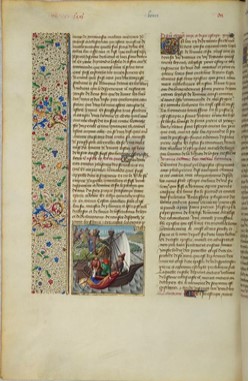
Fig 1 The martyrdom of St. Clement, Source: Français 50, fol. 357v, BnF (Bibliothèque Nationale de France, 2021 ).
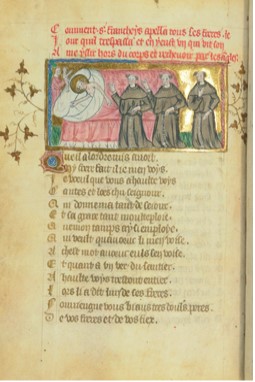
Fig 2 The death of Saint Francis, Source: Français 2093, fol. 81v, BnF (Bibliothèque Nationale de France, 2021) .
A separate large group of miniatures comprises images with scenes of the death of clergymen, mainly popes and bishops, who have acquired a sacralised status within the church’s medieval religiosity. The iconography of the death of clergymen in medieval illumination is more fully represented by images with scenes of burial and inhumation of the body than scenes with passing into eternity, in contrast to the Saints who were depicted at the time of martyrdom. In manuscripts, one most frequently finds images of funerals of popes and bishops who were proclaimed Saints. Characteristic from the standpoint of Gothic iconography and Stylistics is, for example, an illustration from a beautiful example of Parisian court illumination of the 14th century “The life and passions of Saint Denis” (Figure 3).
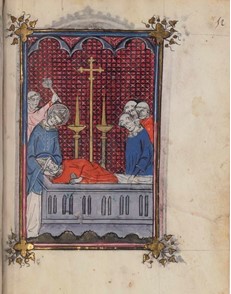
Fig 3 Burial of Saint Santin, Source: Français 13502, fol. 52, BnF (Bibliothèque Nationale de France, 2021) .
The miniature depicts the funeral of Saint Santin, a French bishop and missionary, a disciple of Saint Denis (that is why this illustration is placed in the life). The miniature represents a beautiful version of high Gothic with its inherent features: the composition is subordinated to architectural and tectonic elements, the figures get free from static and acquire linear flexibility, they lengthen, the interpretation of poses and gestures is expressed, although the attraction to applicativeness, theatricality, and convention is still evident, and it is thanks to this that the organic connection of the characters with the wallpaper background and schematically depicted objects of the entourage is preserved. The combination of several points of view is also an inherent feature of medieval painting up to the beginning of the 16th century. In the illustration, Saint Santin is depicted in the image of a contemporary Bishop with all the attributes, the entourage is also appropriate. One of the miniatures depicts the death of Saint Joseph of Arimathea, he is also depicted as a medieval bishop, whose body is laid on a conventionally presented hearse, surrounded by angels with censers performing a funeral rite (Figure 4).
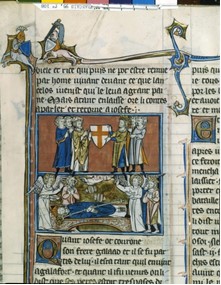
Fig 4 Burial of Joseph of Arimathea, Source: Français 95, fol. 108, BnF (Bibliothèque Nationale de France, 2021) .
The Hand of the Lord extends from heaven to Joseph, testifying to the highest level of holiness and importance of the image. Medieval miniaturists also depict the death of Saint Arsenious, who became a model for hermit monks, according to the ideas about the canons of the transition to eternity of a pious Saint - peaceful, with a blissfully detached expression on his face. Next to the deathbed of the Saint, depicted in the Episcopal tiara, stands a young monk who witnessed a significant event. Significant, because in relation to Saints in the Middle Ages, death was considered a sacred act, and its fact was recorded and revered, more than the day of the Saint’s arrival in the world, as evidenced by hagiographies that call the date of death, not the date of birth.
Lords, rulers, kings. Medieval culture is also described by the sacralization of the ruler’s image. Among the miniatures that unfold the theme of death, images of the King on his deathbed are extremely widely represented, the transition to eternal life has a symbolic meaning and should take place solemnly and publicly. Miniatures depicting the deaths of kings and rulers, historical characters, literary heroes, and contemporaries are quantitatively represented in the Gothic illumination most fully. In Gothic iconography, which went through several consecutive stages of development during the 13th-15th centuries, various variants of depicting the death of monarchs are known. But there are sustainable components that miniaturists invariably use in both early-Gothic samples and late-Gothic miniatures. The ritualized imagery of death, which combines the discourse of sacralization of the religious worldview and sacralization of the monarch’s power, has a stable iconographic model of a representative static nature. The ruler who dies is most frequently depicted lying on a bed and there are always those present next to him. In early iconographic versions, these are one or two characters, and the specifics of late Gothic illumination involve mainly a multi-figure composition (Figure 5), in the XV century often quite detailed (Figure 6).
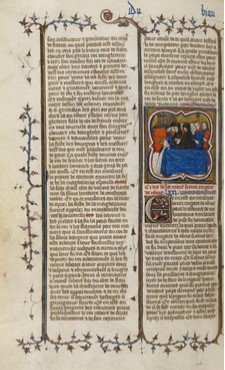
Fig 5 The death of Henry VII,Source: Français 10135, fol. 391v, BnF (Bibliothèque Nationale de France, 2021) .
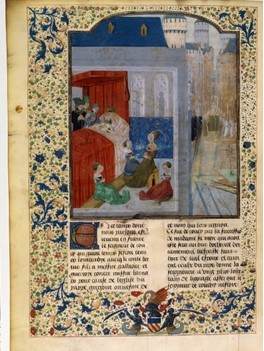
Fig 6 The death of Eduard III,Source: Français 87, fol. 344v, BnF (Bibliothèque Nationale de France, 2021) .
Thus, this iconography belongs to representative models, and is associated not so much with the plot and action, which unfolds through a visual narrative depicting circumstances and details, but with the symbolism of an image that acquires a cult status. The compositional structure here is based on visual parallelism with images of a religious circle, for example, with the scene of the Assumption. This practice of constructing a visual narrative was well-established among medieval miniaturists of the late Middle Ages, and the mechanism of adaptation of compositional solutions was used rather frequently. For example, among the typical scenes for courtly novels are images of feasts and regales, a well-established iconographic scheme was developed for it, related to sacred iconography, namely with “marriage in Cana of Galilee” (Hrynda, 2021) (19).
Warriors. A prominent place in medieval iconography is occupied by death at war and death in battle. That is, the death of a warrior. The idea of a Christian holy war, the idea of a just war, and the idea of chivalric battles based on the principles of the code of honor are expressed in numerous illustration cycles in religious manuscripts (namely in the so-called Cycles to historical Bibles) and secular ones (historical chronicles, treatises). The specific features of depicting death on the battlefield are radically different from ceremonial, representative compositions with scenes of the death of Saints, clergymen, and kings. Death in battle is honorable, and a warrior should accept it fearlessly and courageously. A widespread iconography of death is when a knight leans towards his horse from a death blow with a sword or spear (in Gothic illumination, images of horse duels and battles clearly prevail) (Figure 7) (Français 12565, fol. 155v; Français 60, fol. 119v) (Bibliothèque Nationale de France, 2021) (24).
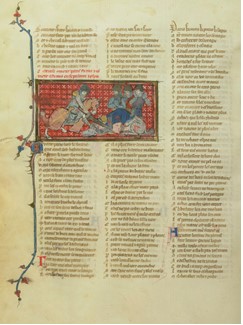
Fig 7 The Death of Paris, Source: Français 60, fol. 119v, BnF (Bibliothèque Nationale de France, 2021) .
When the artist tries to convey the particularly violent and large-scale nature of the battle, he depicts fallen and bloodied knights in unnatural “broken” poses on the pose itself under the hooves of horses of knights-riders who continue the battle (Français 152, fol. 78). In battle miniatures, death is depicted by the fall of a rider from an enemy blow and by a conditional image of bloody wounds (Français 229, fol. 52, BnF). Symbolism and sketchiness, conventionality, emblematic representation of death in battle are inherent in illumination samples dated to the 13th-mid-14th centuries. In the miniature of the 15th century, artists turn to more detailed, concretised plot images, wherein scenes of murder in war have a more realistic nature of reproduction. Death in battle, especially in the late Middle Ages, takes on another semantic sound, namely adventurous. The knight finds himself in the face of death, taking the path of finding adventure and overcoming difficulties on the road, or performing at a tournament. The Gothic miniature gives an expanded chivalrous iconography, wherein the image of death appears as one of the most important. The adventurous hero had to travel, seek risky venture, overcome difficulties and be ready to face death in different guises - whether a rival or an enemy (Français 101, fol. 109; Français 111, fol. 95v), whether it is a character from the world of the extraordinary and supernatural, for example, a dragon (Français 112 (3), fol. 147; Français 118, fol. 296v). Most of the images represent a duel between two knights, which most often ends with the death of one of them (Figure 8).
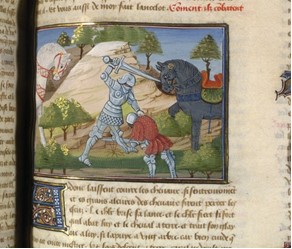
Fig 8 The Battle of Lancelot and Margond, Source: Français 111, fol. 131, BnF (Bibliothèque Nationale de France, 2021) .
They engage in duels without fear and with a willingness to accept death. In the image, this is conveyed schematically. Most of them depicted scenes of a duel between two riders or dismounted knights with swords. In Arthur’s novels, illuminated in the 15th century, artists prefer courtly subjects, wherein the concept of military valour is replaced by the idea of competition and rivalry, an individual military feat. Therefore, in the lists of novels of the fifteenth century, among the most popular - the image of two knights in armour on horseback during a fight. Even though the composition seems typically monotonous, the entourage of the scene has a symbolic meaning: the battle is mostly depicted in front of the tower, which was interpreted as a symbol of the power of the feudal lord and became a figurative embodiment of the idea of competition (Duby, 1993) (27). In chivalric romance iconography, the idea of military courage and valour, represented in the image of a duel between two armies or two knights, is the embodiment of the idea of the ideal of a warrior knight who enters battle, performing feat after feat.
Women. In late Gothic iconography, the problem of gender clearly begins to sound, since female images are included in its structure at diverse levels: sacred (the cult of the Virgin and Saints) and profane (the cult of the fair lady). The image of the “female” death is also visualized in miniature. At the same time, the image of the death of a child in medieval iconography is presented very fragmentary. In the iconography of female death, there are no representative scenes with the image on the deathbed surrounded by witnesses. More characteristic is the appeal to plot compositions, where female death is rather situational. Most frequently, a woman is depicted who loses consciousness and falls, and another character from the stage supports her under her arms. Gender themes are particularly prominent in fiction, namely in the texts of the courtly tradition. Extensive visual narratives complement chivalrous novels, primarily the Arthur cycle. There, the heroines act as active co-creators of the story, their images and actions are tied to numerous plot conflicts. The theme of death permeates Arthur’s novels because adventurism, risk, competition, and struggle form the basis in the unfolding of the narrative. It is these figurative determinants that shape the specific features of visualising the death of female characters. The most typical image for a miniaturist is the image of the very moment of death, frequently surrounded by eyewitnesses. Often artists focus on physiological details, depicting wounds, or, for example, bloody murder weapons. According to this principle, the composition with the death scene of Dame de Béloé from the list of the novel “The Death of King Arthur”, illuminated in central France at the end of the 15th century, was solved (Figure 9).
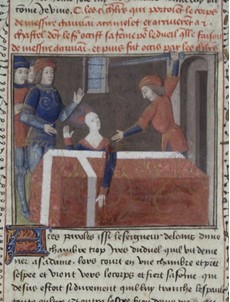
Fig 9 The death of Dame de Béloé,Source: Français 112 (3), fol. 224, BnF (Bibliothèque Nationale de France, 2021) .
After learning of Gauvin’s death, a woman married to another mourns her lover, and an angry man kills her. In the composition, attention is focused on the act of violence, the very moment of causing a fatal wound is depicted, this scene is supplemented with witness characters who confirm the authenticity of events for the viewer, who is also an eyewitness. Specific visual storytelling allowed the reader not just to contemplate static figures, but to observe them, “hearing” how they speak, imagining how they move. This method of presenting images can be compared in modern culture, for example, with animation or motion-picture photography (Hrynda, 2021) (25). In addition, most of the illustrations depict “the moment before” death, allowing the reader to complete the scene in imagination (Linda, 2015) (26). An obvious threat looms over the victim, the killer swings before delivering a fatal blow (Figure 10). The doomed do not offer any resistance, that is, death is inevitable, and the viewer is deliberately led to this.
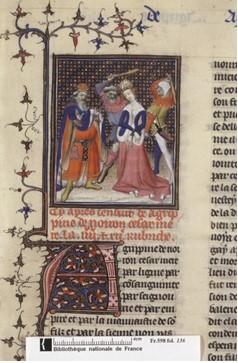
Fig 10 Murder of Agrippina, Source: Français 598, fol. 136, BnF (Bibliothèque Nationale de France, 2021) .
Medieval miniaturists depicted not only women who die, but also women who kill. An illustration depicting the death of a Macedonian Princess, Cleopatra’s daughter, at the hands of a jealous and vindictive rival Olympias (both were wives of Philip II) combines these iconographic motifs (Figure 11).
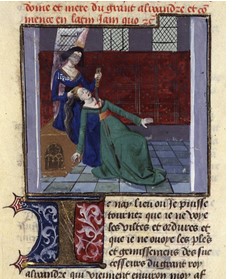
Fig 11 Olympias kills Cleopatra’s daughter, Source: Français 230, fol. 110v, BnF (Bibliothèque Nationale de France, 2021) .
Again, the miniaturist refers to a proven iconographic model: the moment of violence, the death of the heroine, the image of attributes and tools that lead to the death of the character.
Violent death. A separate group in Gothic illumination comprises miniatures that depict the violent death of a character, mostly his murder, or death that occurred unexpectedly under tragic circumstances. Here, miniaturists also used well-established iconographic approaches, depicting the moment of death, a violent act, focusing compositional attention on the victim. For the most part, the scene unfolds like a symbolic duopoly - killer-victim, and in the presence of other additional characters. However, the introduction of “viewers” into the composition is a typical practice in Gothic iconography: eyewitnesses, witnesses, as it were, legitimise history, create a dimension of reality that can convince the audience of the authenticity of the events depicted (examples of illustrations). Visualisation is based on the principles of a fairly literal narrative, when the viewer can read all the circumstances of the event and at the same time attention is fixed on the actual moment of death, i.e., miniaturists clearly present cause-and-effect relationships that determine the climax of the plot dénouement, which is actually the moment of murder/death. In general, this type of construction of visual narratives based on the principle of storytelling, but with accent symbolism of individual elements of the composition, is typical for gothic imagery.
Typical examples of the outlined iconography are miniatures illustrating various subjects - whether sacred biblical, historical, or artistic and secular literary traditions, but they are united by the semantics of interpretation of images related to the theme of death, dying. For example, the accidental death of Cain at the hands of a blinded ploughman who was hunting with his young son (Français 226, fol. 6v; Français 22531, fol. 12; Français 1753, fol. 3v; Français 5, fol. 11v), the murder of the Egyptian pharaoh Nectanebo, presented traditionally in the entourage and environment of the then recognisable reality (Figure 12) (Français 50, fol. 123; Français 316, fol. 184v), the assassination of the Assyrian king Sin-ahhe-eriba, against whom his own sons rebelled, executing him in the temple during the sacrifice (Français 3, fol. 173), the murder of Gaius Julius Caesar, who was stabbed with a dagger at a meeting of the Roman Senate (Français 40, fol. 219; Français 50, fol. 187), or the murder of Agamemnon (Français 226, fol. 27), or the death of the ancestor of Lancelot of the Lake, King Lancelot the Ancient, who was treacherously and cruelly killed by the Duke of Belle Gard, cutting off his head over a miraculous boiling spring (Figure 13) (Français 113, fol. 116): the semantics of iconography direct the viewer towards a narrative that reveals the circumstances of death, focusing on the pair of main characters “killer-victim”.
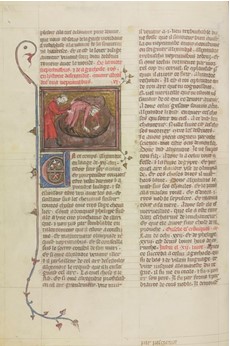
Fig 12 The Murder of Nectanebus, Source: Français 316, fol. 184v, BnF (Bibliothèque Nationale de France, 2021) .
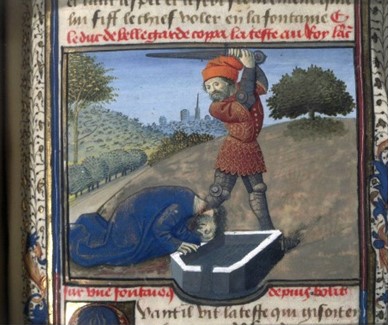
Fig 13 The Murder of Lancelot the Ancient,Source: Français 113, fol. 116, BnF (Bibliothèque Nationale de France, 2021) .
Suicide. Scenes depicting suicide are also present in the iconographic typology associated with the theme of death. For the most part, suicidal motives relate to historical characters appearing in texts related to ancient history, most often ancient. There are also images of suicides in modern medieval secular literature. For a miniaturist, the main task is to tell the story of suicide - how exactly and under what circumstances the hero or heroine committed suicide, traditionally for the iconography of death, they recreate the actual moment of suicide. Again, as in the case of the typology of violent death, there is an “eyewitness syndrome”: the viewer must learn the truth, see this death as it was inflicted. Such narrative visibility is realised in one form or another, depending on the plot - in suicidal scenes, regardless of who is depicted: a monarch, a warrior, or a woman. Suicide of Dydo (Français 229, fol. 56; Français 230, fol. 39v), Lucretia (Figure 14) (Français 43, fol. 26; Français 53, fol. 18v; Français 286, fol. 283) Arachne (Français 137, fol. 75v; Français 598, fol. 29), Jocasta (Français 229, fol. 14), Hippodamia (Français 598, fol. 83; Français 599, fol. 47v), Cleopatra and Anthony (Français 226, fol. 183v; Français 229, fol. 265; Français 598, fol. 128v) - the most popular heroines of the ancient historical and literary tradition among those illustrating the works of Boccaccio, Christine de Pizan, Valeria Maxim. The theme of suicide is also visualised in the death scenes of Judah, Nero, Hannibal, Pilates, Sardanapal, Demosthenes, Diocletian. The techniques of visual storytelling, which French miniaturists use to illustrate suicidal scenes, include images before and after, i.e., consecutive pictures where a suicide is depicted, and the already dead body of the hero or heroine (Figure 15). But more common is detailed and literal visibility, when detailed circumstances accompanying the moment of suicide are depicted - visual documentation of the event.
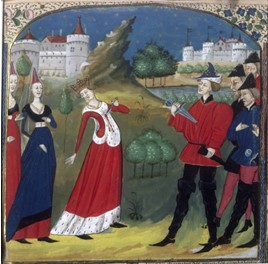
Fig 14 Lucrezia’s Suicide, Source: Français 43, fol. 26, BnF (Bibliothèque Nationale de France, 2021) .
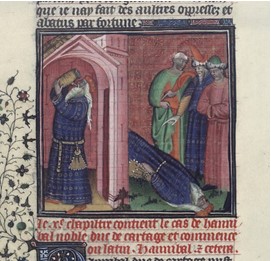
Fig 15 Hannibal’s Suicide, Source: Français 226, fol. 140v, BnF (Bibliothèque Nationale de France, 2021) .
The image of the death of the "elite", i.e. the death of saints, popes, kings, knights and aristocrats, is reproduced in the Gothic miniature in its entirety, both quantitatively and qualitatively, if this refers to the variability of the iconography and the breadth of the coverage of the subjects. At the same time, the image of the death of ordinary people is much more modest. There are scenes where we can see images of the death of pilgrims, monks, or burghers, but more often they are clearly plot-based, rather than figurative and symbolic (Ziak et al., 2022; Koniratbay et al., 2023) (28,29).
The iconography of death in French illuminated manuscripts of the 13th-15th centuries demonstrates a remarkable diversity of motifs and approaches to representing mortality. While scenes of righteous deaths of saints and clergy broadly conform to conventions establishing their sacred status, images of dying monarchs, knights, women, and villains showcase more variety. Across manuscripts, certain common compositional techniques recurred for maximizing legibility, including the deathbed surrounded by witnesses, the horizontal body, and the depiction of figures in their contemporary social roles (Sabirzyanova et al., 2022) (30). Yet at the same time, illuminators adapted these standard formats to make the death vignettes more narratively vivid and symbolically potent (Lim, & Linares Matás, 2023; Marzhan et al., 2022) (31.32).
The specificity and hybridity of Gothic death iconography reflects how fully entwined macabre themes had become with both religious doctrine and chivalric lore. Whether depicting a serene heavenly death or a gory assassination, these illuminated miniatures visualized death in a way that resonated with multiple dimensions of late medieval culture (Olianina, 2023) (33). The prevalence of these often-gruesome mortality motifs demonstrates that death had a dominant presence in the medieval imagination (Tleubekova et al., 2023) (34). However, the diversity of approaches, encompassing pathos, spirituality, horror, and detachment, also reveals the interpretive openness with which society engaged the perplexing mystery of death. As artifacts of medieval visuality, these manuscripts provide a rich entry point into the mentalities of an era spellbound by death (Zhussupov et al., 2017) (35).
While this study conducted an extensive examination of recurring motifs related to death across French Gothic illuminated manuscripts, its scope was necessarily limited. The analysis focused only on manuscripts produced in France during the 13th to 15th centuries, excluding examples from other European regions and eras. The study also centered primarily on Christian iconography, not delving deeply into any potential influences from Jewish or Islamic artistic traditions. Though it touched on secular literary works, the analysis prioritized religious texts and Biblical themes over motifs derived solely from romances or chronicles. Moreover, the study analyzed the iconographic content without examining the wider social context and functions of these manuscripts. Issues like patterns of patronage and ownership, intended audience, and reception among contemporary viewers remain outside this particular art historical inquiry. Given the richness of death-related iconography in medieval book painting, this study represents just an initial foray analyzing certain aspects, while much remains to be explored regarding influences, meaning, and impact.
4. Conclusions
The research into Gothic illuminated manuscripts has shed significant light on the medieval perceptions of mortality, particularly during the late medieval period. Through meticulous analysis of the visual motifs that recur in French manuscripts from the 13th to the 15th centuries, the study has carved out multiple arguments that enhance our understanding of the era's mindset toward death. It has been observed that the illuminators of these manuscripts did not solely rely on Christian theological frameworks but also integrated elements of contemporary folk beliefs into their depictions. These artists skillfully blended typical representations, such as the sanctified deathbed scene, with more ominous and earthy symbols that hint at underlying superstitions still present among the populace. This amalgamation of the sacred and the folkloric offers a fuller picture of the period's complex belief systems.
The study found that while there were standard iconographic templates for representing various societal figures such as saints, kings, and women, these were not rigidly applied. Instead, illuminators employed creative flexibility to heighten the narrative's emotional impact, tailoring the imagery to fit the particular context and imbue it with a specific mood or atmosphere. Such artistic choices suggest a dynamic approach to manuscript illumination, aimed at engaging the viewer more deeply. Moreover, the wide-ranging and often macabre death-related motifs that permeate these manuscripts underline how deeply ingrained these themes were within the medieval cultural consciousness. This iconography served a dual purpose: provoking contemplation of the afterlife and simultaneously entertaining its audience. The presence of these motifs in both sacred and secular contexts points to a society preoccupied with death, yet finding a place for it in various aspects of daily life.
The diverse methods of portraying death, ranging from the detached to the overtly graphic, are indicative of medieval society's multifaceted and sometimes ambiguous relationship with mortality and violence. This variability suggests that there was no single, monolithic approach to death, but rather a spectrum of interpretations and attitudes towards this inevitable aspect of life. Gothic illuminated manuscripts offer a window into the intricate visual language of the late medieval period regarding death. Illuminators created a complex tapestry of symbols that wove together theological, folkloric, and cultural strands, making them legible to their contemporaries. These works not only reveal the period's rich visual culture but also continue to provide fertile ground for interdisciplinary scholarly investigation, attesting to their enduring cultural significance.
Future research into the iconography of death in medieval illuminated manuscripts could embark on several intriguing paths. Scholars might conduct comparative analyses to uncover regional differences in death motifs by examining manuscripts from various European locales, such as England, Germany, and Italy. Investigating how different faiths, including Christian, Jewish, and Islamic traditions, influenced each other's artistic representation of death could also offer new insights. A focus on secular texts, like chivalric romances, could shift the lens from the more commonly scrutinized Biblical and religious materials. Additionally, tracing the evolution of death iconography in relation to changes in medieval artistic techniques could reveal stylistic transitions.
Understanding the manuscripts through the lens of patronage and audience could clarify the purpose behind particularly macabre images. How medieval viewers engaged with and interpreted mortality symbolism is another potential avenue, as is an interdisciplinary approach incorporating anthropology, philosophy, and theology to grasp the broader cultural impact of these death motifs. Comparisons between manuscript iconography and other medieval artworks, such as tomb sculptures and frescoes, would also enrich the dialogue, as would an exploration of how medieval themes of macabre persisted into early modern and contemporary art and literature.















